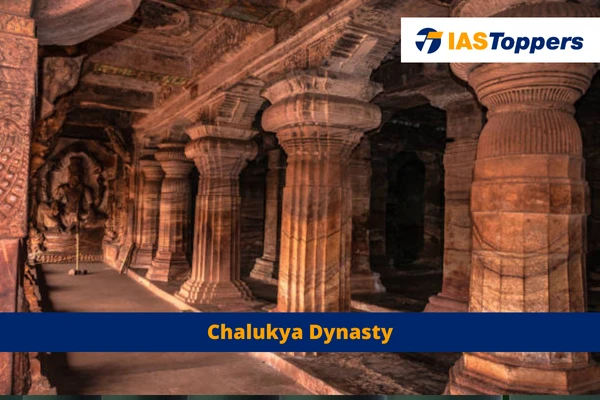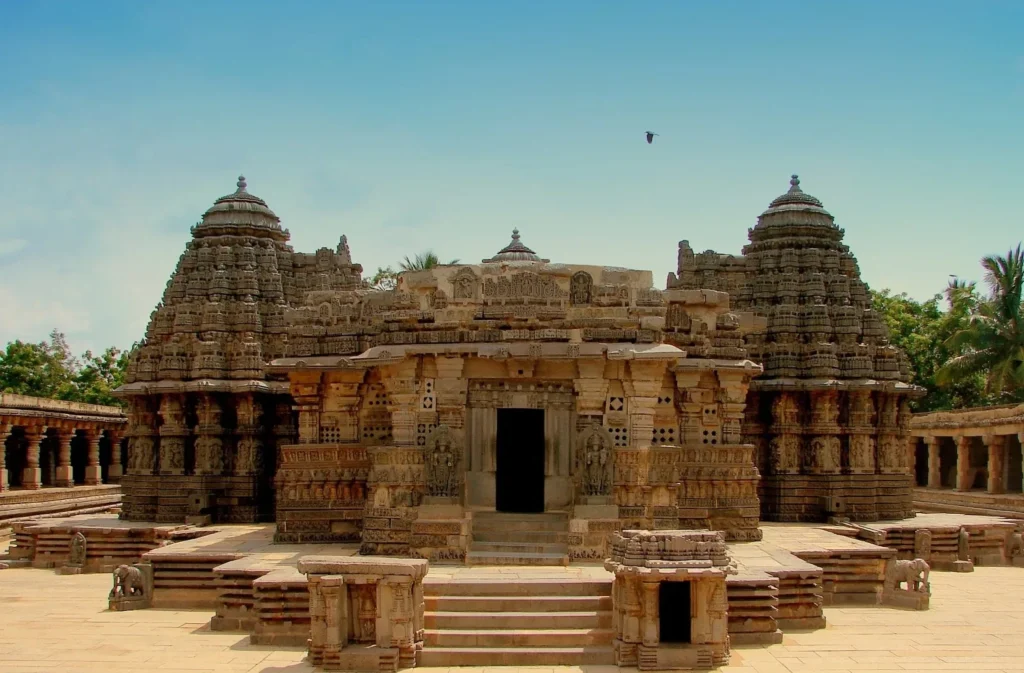The rule of the Chalukyas marks an important milestone in the history of South India and a golden age in the history of Karnataka. The political atmosphere in South India shifted from smaller kingdoms to large empires with the ascendancy of Badami Chalukyas. A Southern India-based kingdom took control and consolidated the entire region between the Kaveri and the Narmada rivers. The rise of this empire saw the birth of efficient administration, overseas trade and commerce and the development of new style of architecture called “Chalukyan architecture“.
Studying Chalukya dynasty will be helpful for UPSC IAS Exam preparation. Mains GS paper-1 Medieval Indian History.
Table of Content:
- About Badami Chalukya dynasty
- Periods in Badami Chalukya history
- Administration of Badamin Chalukya
- Conclusion
- Frequently Asked Questions (FAQs)
About Badami Chalukya dynasty
- The Chalukya dynasty was a Classical Indian dynasty that ruled large parts of southern and central India between the 6th and the 12th centuries.
- During this period, they ruled as three related yet individual dynasties. The earliest dynasty, known as the “Badami Chalukyas“, ruled from Vatapi (modern Badami) from the middle of the 6th century.
- The Badami Chalukyas began to assert their independence at the decline of the Kadamba kingdom of Banavasi and rapidly rose to prominence during the reign of Pulakeshin II.
Periods in Badami Chalukya history:
- In the 6th century, with the decline of the Gupta dynasty and their immediate successors in northern India, major changes began to happen in the area south of the Vindhyas – the Deccan and Tamilakam.
- The age of small kingdoms had given way to large empires in this region.
Pulakeshin I
- The Chalukya dynasty was established by Pulakeshin I in 543.
- Pulakeshin I was a petty chieftain of Pattadakal in the Bijapur district whose reign began in 543, took and fortified the hill fort of Vatapi (modern Badami) made it his capital.
- He seized control of the territory between the Krishna and Tungabhadra rivers and the Western Ghats.
- Pulakeshin I and his descendants are referred to as “Chalukyas of Badami“.
Kirtivarman I
- Son of Pulakeshin I, Kirtivarman I (reigned 566–597) secured the valuable Konkan coast.
- The family then turned its attention to the fertile coastal regions to the northwest and east of the peninsula.
Pulakeshin II
- Pulakeshin II, whose pre-coronation name was Ereya, commanded control over the entire Deccan and is perhaps the most well-known emperor of the Badami dynasty.
- He is considered one of the notable kings in Indian history.
- He extended the Chalukya Empire up to the northern extents of the Pallava kingdom and halted the southward march of Harsha by defeating him on the banks of the river Narmada.
- He then defeated the Vishnukundins in the south-eastern Deccan.
- Pallava Narasimhavarman reversed this victory in 642 by attacking and occupying Badami temporarily.
- It is presumed Pulakeshin II, “the great hero”, died fighting.
Vikramaditya I
- The Badami Chalukya dynasty went into a brief decline following the death of Pulakesin II due to internal feuds.
- It recovered during the reign of Vikramaditya I, who succeeded in pushing the Pallavas out of Badami and restoring order to the empire.
- Vikramaditya I took the title “Rajamalla” (“Sovereign of the Mallas” or Pallavas).
Vijayaditya
- The thirty-seven year rule of Vijayaditya (696–733) was a prosperous one and is known for prolific temple building activity.
Vikramaditya II
- The empire was its peak again during the rule of the illustrious Vikramaditya II (733–744).
- He is known not only for his repeated invasions of the territory of Tondaimandalam and his subsequent victories over Pallava Nandivarman II, but also for his benevolence towards the people and the monuments of Kanchipuram, the Pallava capital.
- He thus avenged the earlier humiliation of the Chalukyas by the Pallavas and engraved a Kannada inscription on the victory pillar at the Kailasanatha Temple.
- During his reign Arab intruders of the Caliphal province of Sind invaded southern Gujarat which was under Chalukya rule.
- The Arabs were defeated and driven out by Avanijanashraya Pulakeshin, the governor of the Chalukya branch of Navsari.
- Vikramaditya II later overran the other traditional kingdoms of Tamil country, the Pandyas, the Cholas and the Cheras in addition to subduing a Kalabhra ruler.
Kirtivarman II
- The Rashtrakuta Dantidurga overthrew the last Badami Chalukya king Kirtivarman II in 753.
- At their peak they ruled a vast empire stretching from the Kaveri to the Narmada.
Administration of Badamin Chalukya:
King:
- King was the highest officer of the state.
- He was the highest judicial authority and was the head of the administrative council.
- He ruled in accordance with the rules of their dynasties.
- He used to seek the advice of other experienced persons in matters of administration, and other related programmes, etc.
- The chief queen of the king was called ‘Tattamahish’.
- The prince was appointed on the post of Yuvaraja.
Council of ministers and other officers:
- There was a council of ministers to advise the king and to help him in administration.
- The chief/prime minister was called Mahamatya.
- Besides ministers there were other officers who helped the king in administration of the state.
- The administration of Mandal was called Mahamandaleshwara.
- The chief of the army was called Dandadhipatya.
- The heads of the village and law department were called Visayika and Adhishthanaka.
Provincial administration:
- The entire empire was divided into provinces and other units.
- Mandal was the unit of the empire and its administrator was called Mahamandaleshwara.
- He supervised and controlled his subordinate officials.
- He had also the power to either punish or promote them.
- Village was called Visha and its head was called Vishayaka.
- A special official called Pattaiika was appointed for the realization of revenue.
Local administration:
- The entire empire was divided into villages.
- The villages were locally administered by gram sabha and gram panchayat.
- Its head was called vishayaka.
- Like villages, city councils were also entitled for local and self administration.
Military organization:
- Chalukya had ‘Chaturangini’ or four winged army.
- A great importance was attached to the army of elephants.
- King was the supreme commander of the army.
- Danda Nayaka or Dandadhipatya performed the duties of Senapati.
- Samantas maintained their separate armies and helped their icings as and when their help was required.
Judicial system:
- There were separate military and civil courts during the reign of Chalukyas.
- King was the highest judicial authority and gave his decision in accordance with conventions and on the advice of his ministers.
- All sorts of punishments such as imprisonment, exile, fines and sentence to death etc. were prevalent in his period.
Sources of revenue:
- Land revenue was main income of the state.
- Land revenue was charged at the rate of 1/6 of the production.
- It was the duty of the Pattaiika that the revenue thus charged should reach the government treasury.
- Besides land tax there were other sorts of taxes such as Xutanamaka, which is known as a tax for pilgrimage, tax on prostitutes, etc.
- Fine imposed by the courts also formed the revenue of the states.
- Law of ‘transferred property’ was applied for the property of a person who died without leaving a son.
- That is to say that property was confiscated by the state.
- Meadows, forests, mines etc. were also the means of the income of state.
- Taxes on different trades also formed a considerable part of the income of the state as well.
Conclusion:
Chalukyas was one of the most prominent dynasties of the medieval period. They had a highly centralized administrative system where all the powers were concentrated in the hands of the king but there was a council of ministers and other officers to advise the king and assist him in administration.
Ref: Source-1
| Other Articles in History & Culture | |
| Magadha Empire | Ashoka’s Dhamma |
| Indus Valley Civilization Sculpture | Tripitaka |
| Pala Dynasty | Gupta Coins |
FAQs (Frequently Asked Questions)
Who is Mahamatya?
Prime minister of Chalukyas.
Who is Dandadhipatya?
He is the chief of army.
What type of administrative system Chalukya had?
They had a centralized administrative system.



